Dennis Cove Falls
Dennis Cove, Carter, Tennessee
Dennis Cove Falls (7/01/2006, 55 mm, f/29, 5 sec, ISO 100 hi res photo)
Description
The Dennis Cove Recreation area is just chock full of nice waterfalls. I'm still working on getting to all of them. My sons and I took a one night camping trip to Dennis Cove and hiked up to these falls the next morning. We also stopped to take in Lower Dennis Cove Falls just below the falls shown here. We hiked toCoon Den Falls the previous evening, as well as taking a quick trip to Laurel Fallsfor - you guessed it - more photo ops.
Not yet visited in the area are Middle Laurel Falls, Upper Laurel Falls, and Firescald Branch Falls.
I really liked Dennis Cove Falls. The location is great, very quiet and serene. Rhododendron are a dime a dozen. There is enough volume from Laurel Fork to generate a nice, rumble. Plus, there are convenient rocks and tree roots for lounging around the base of the falls.
Getting There
Drive east on U.S. 321 out of Hampton, Tennessee for 0.8 miles. Turn right onto Dennis Cove Rd. The road is marked with a small, brown national forest campground sign but it's easy to miss. It looks like you're turning into a residential area and you are. Drive on through and the road will head up.
Be prepared for a winding mountain road. I know. You're shocked.
About 4 miles from U.S. 321 will be a small parking area on the left side of the road for the Appalachian Trail and Laurel Falls. About 0.8 miles past this is the Dennis Cove Campground. Park here. The trailhead is on the opposite side of Laurel Fork, which you crossed just before turning into the campground. Hike back along the road, over the bridge, and the trail to Dennis Cove Falls will be directly on your left.
Hike Details
|
This is a bit of an adventurous hike. It isn't exactly difficult. The elevation gain is only about 300 feet. BUT, it is fun. You have 3 creek crossings to figure out. How you do them is up to you. My 6 year old son waded across. My older son worked really hard and managed to traverse the crossings without getting wet. I had to work at it but was also successful. Yes, it was somewhat amusing for them to see me trying to balance on the rocks with a photo backpack and tripod case. My trekking poles were of great assistance, I have to say. |
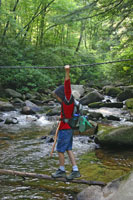
Crossing #1 |
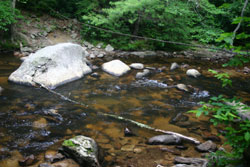
Crossing #2 |
At stream crossing #1, there is a cable to hold onto overhead as you balance over a small log. I'm sure the log is washed away frequently and replaced. Anyway, the cable is pretty high. My son could barely reach it and he is about 5'4" or so. As crossing #2, there was no usable log so we rock hopped across. Again, the smallest one waded. It is the safest way across. |
|
Crossing #3 is directly over a small, 3' drop in the stream, while the steel cable is several feet downriver. Go figure. So this one is a combination rock hop and log balancing act. One final note. My oldest son took a boy scout backpacking trip here last summer and had to wade across due to higher flow conditions. My recommendation: play it safe and bring wading shoes as a backup. |
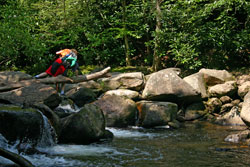
Crossing #3 |
The main hiking trail doesn't go to the base of Dennis Cove falls so keep an eye out for the small side trail going down just after you hear the roar of the waterfall.
Photo Tips
Another great photo day. There was little-to-no wind and I barely got there before the sun did. Excellent!
I think the pictures turned out fabulous. If you want a larger version, go to thewaterfall wallpaper page and download it there.
There is plenty of room at the base of Dennis Cove Falls for taking photos. Of course you need your handy, dandy tripod.
For the most part a horizontal format works the best here. I played around with some foreground elements and liked a few of those as well. Try the moss covered rocks and/or logs as foreground to give the image more depth.
A normal-to-wide angle lens will be required as you are fairly close to the waterfall. I also recommend a polarizer to reduce the glare on the rocks and water.
There are no problems with bright skies or horizon issues but if the sun is out or if the clouds are thin you could have problems with overexposure on the water. Try bracketing some, as much as 1 stop underexposure or so. The vertical picture you see to the left is a composite of three pictures taken at different exposure levels and combined in photoshop. Stay tuned for some tutorials on how to do neat stuff like that.
Waterfall-Picture-Guide › Tennessee Waterfalls › Dennis Cove Falls


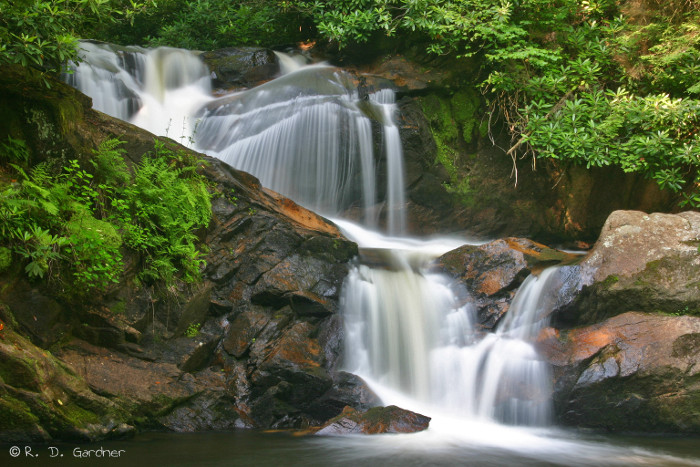

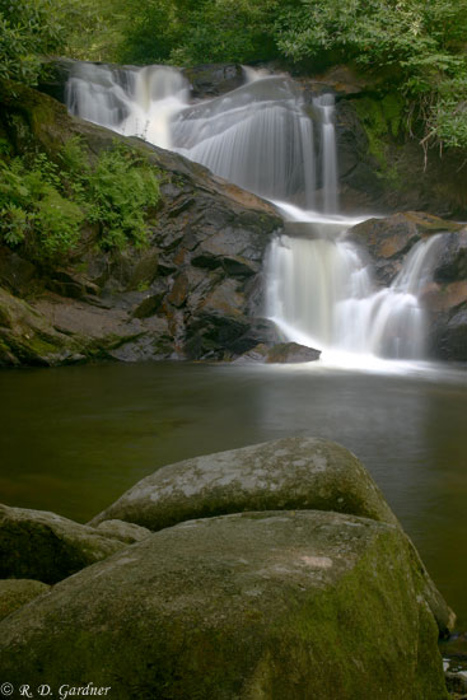
New! Comments
Have your say about what you just read! Leave me a comment in the box below.